Abstract
Dunican, Lawrence K. (Cornell University, Ithaca, N. Y.) and Harry W. Seeley. Starch hydrolysis by Streptococcus equinus. J. Bacteriol. 82:264–269. 1962.—In a study of starch hydrolysis by strains of Streptococcus equinus, 52 isolates were obtained and their amylolytic abilities determined. It was found that all the strains could hydrolyze starch to some extent when grown in the presence of an easily fermentable carbohydrate, viz., glucose. Without this carbohydrate the organisms did not hydrolyze starch. The hydrolysis of starch was inhibited when the organisms were grown in an atmosphere of 5% CO2 and 95% N2, even if grown in the presence of a fermentable monosaccharide. S. bovis, which was used as a reference organism, readily hydrolyzed starch in the absence of monosaccharides and in atmospheres containing CO2. In no instance did S. equinus hydrolyze the starch to the level of reducing sugars. Negligible amounts of reducing sugars were recovered when the cell-free filtrates of S. equinus were incubated with starch. With S. bovis, the yield of reducing sugars under such conditions was almost quantitative. These facts extend further the differences between these related organisms.
The ability to synthesize an internal starchlike polysaccharide was noted in most of the strains of S. equinus. Synthesis was found when the organisms were grown on maltose or on a starch medium containing a small amount of fermentable monosaccharide.
Full text
PDF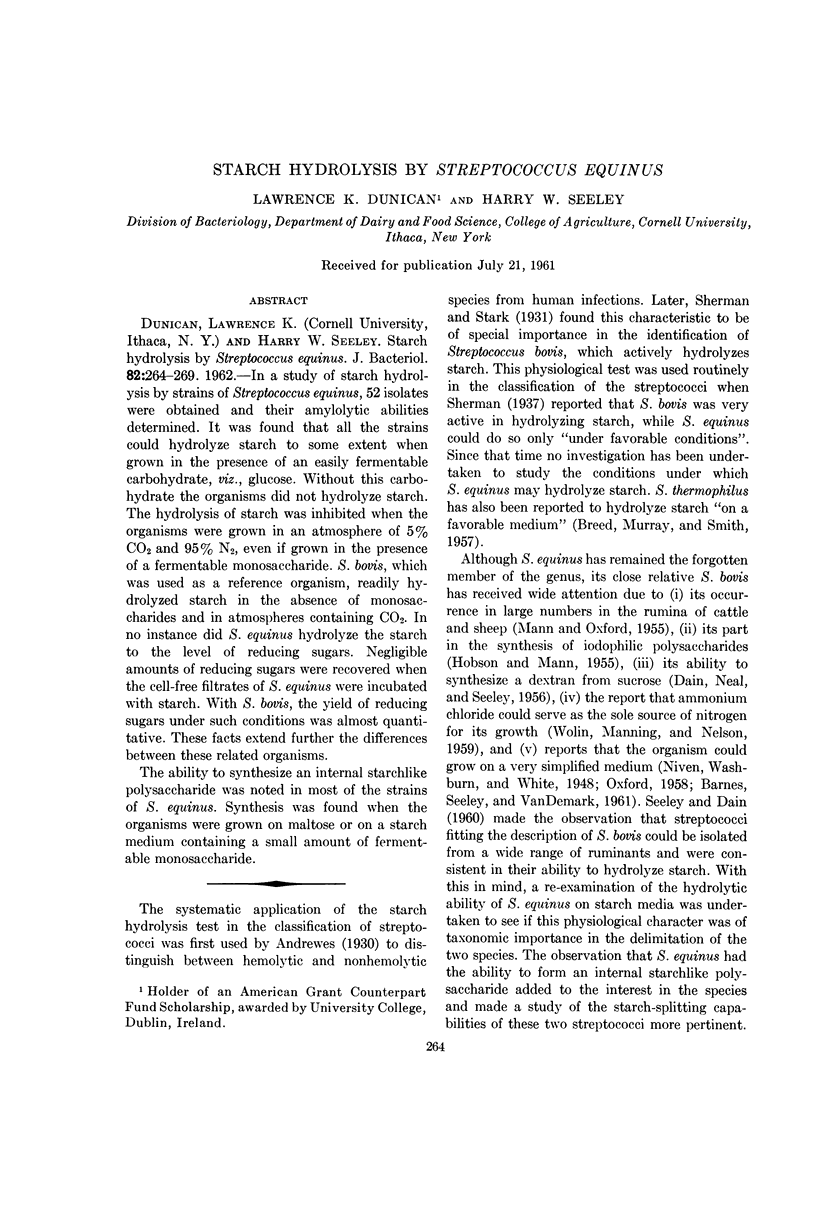
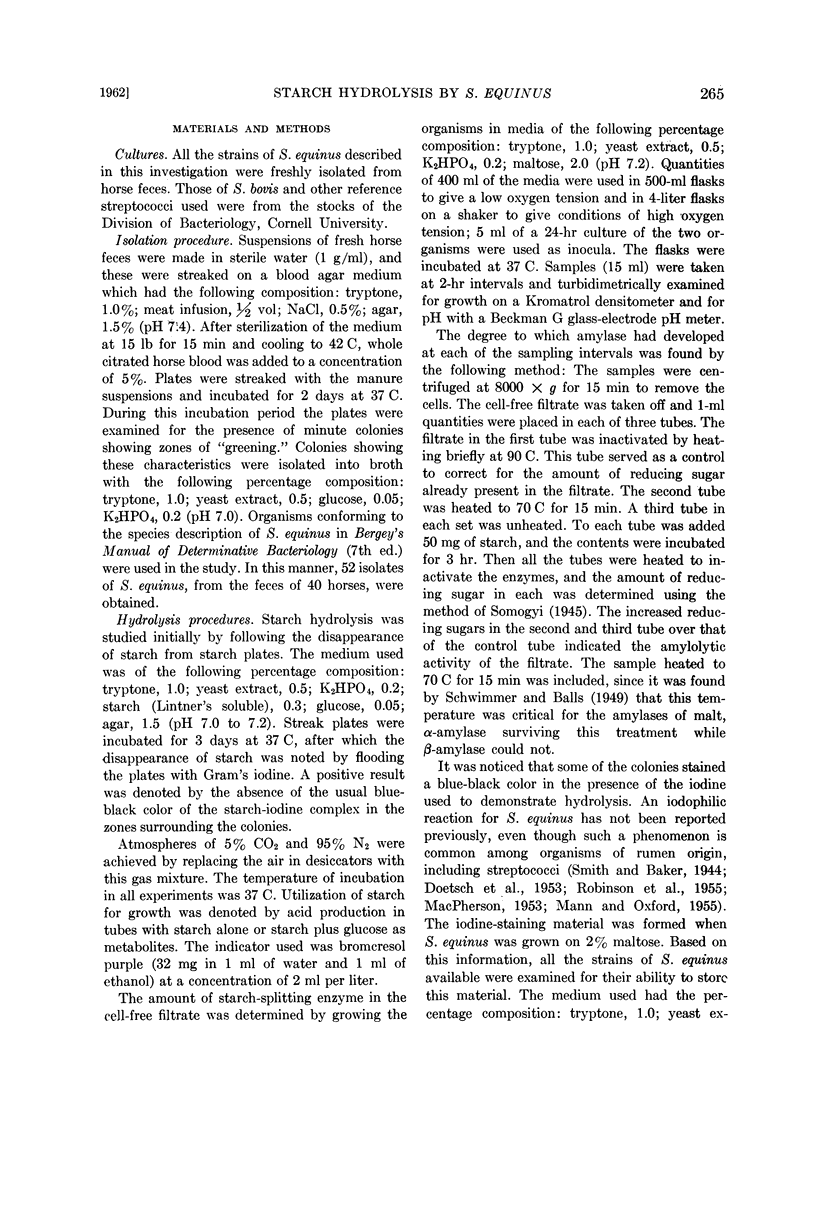
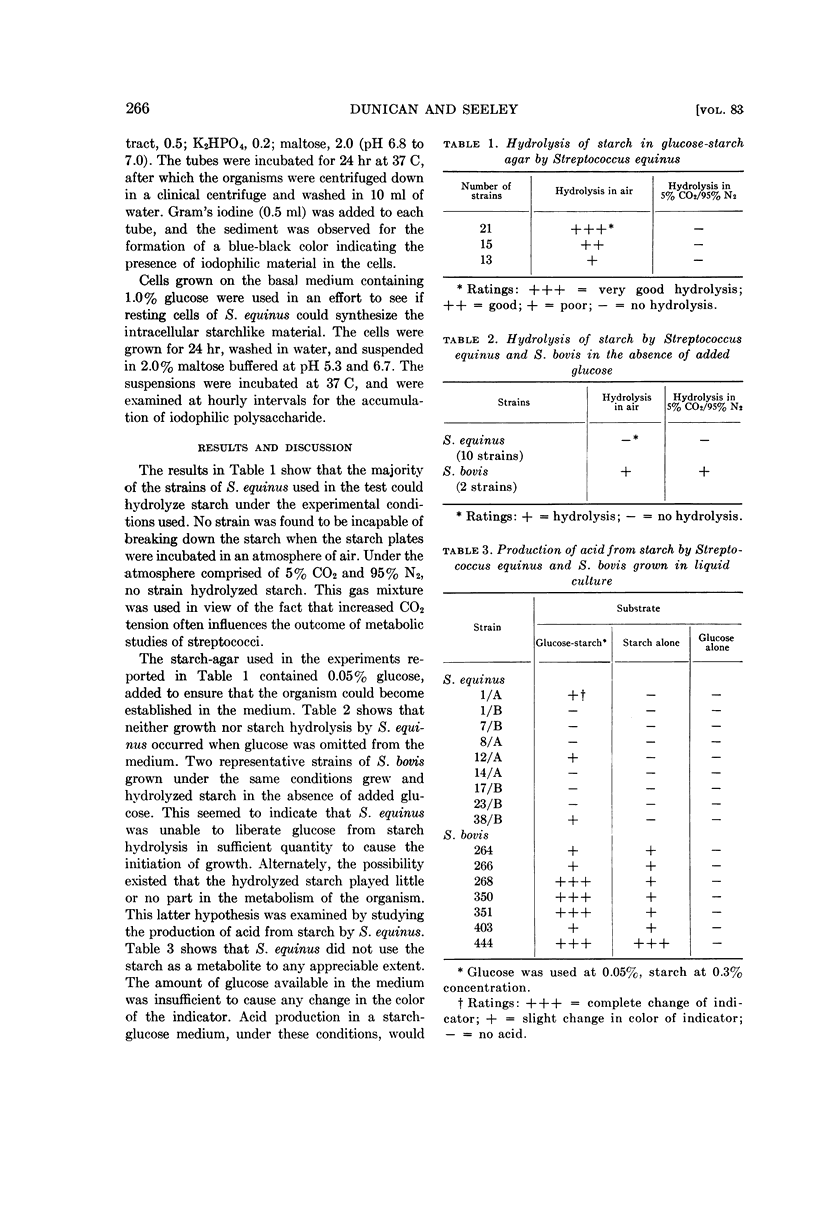
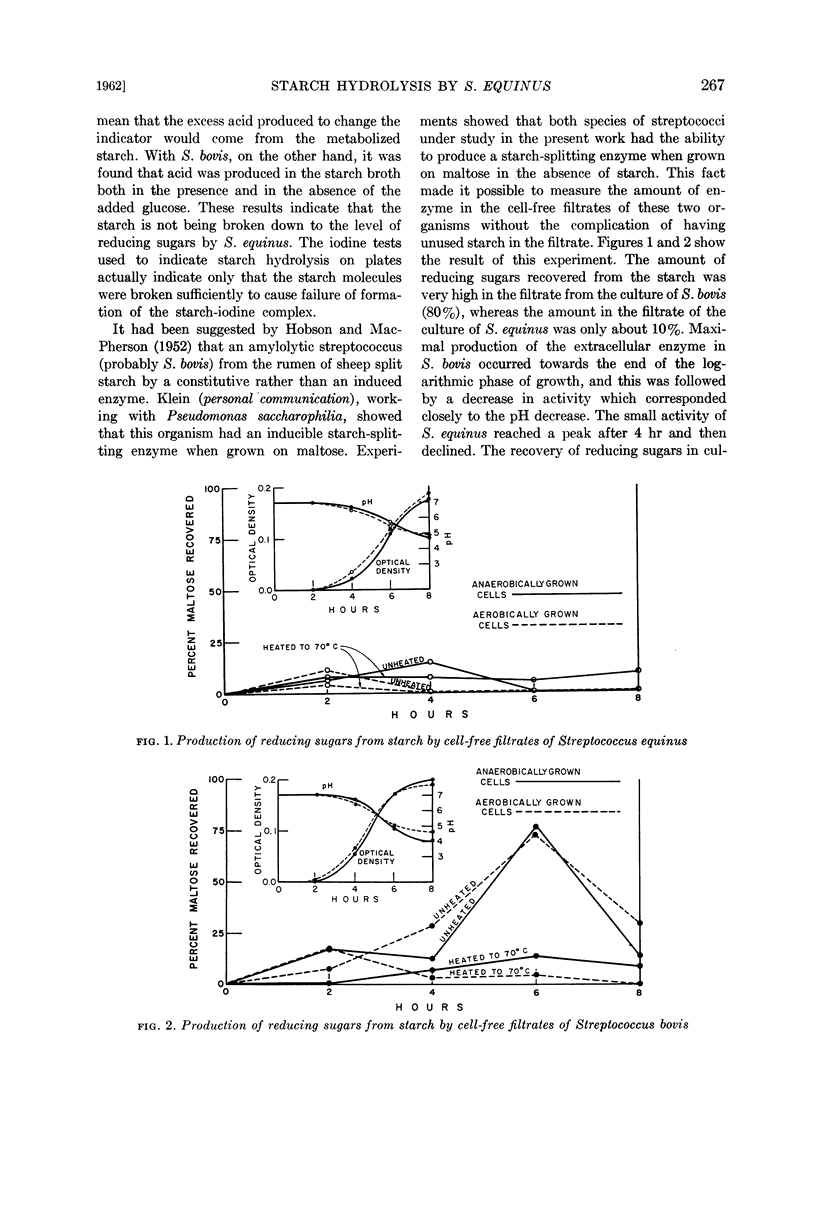
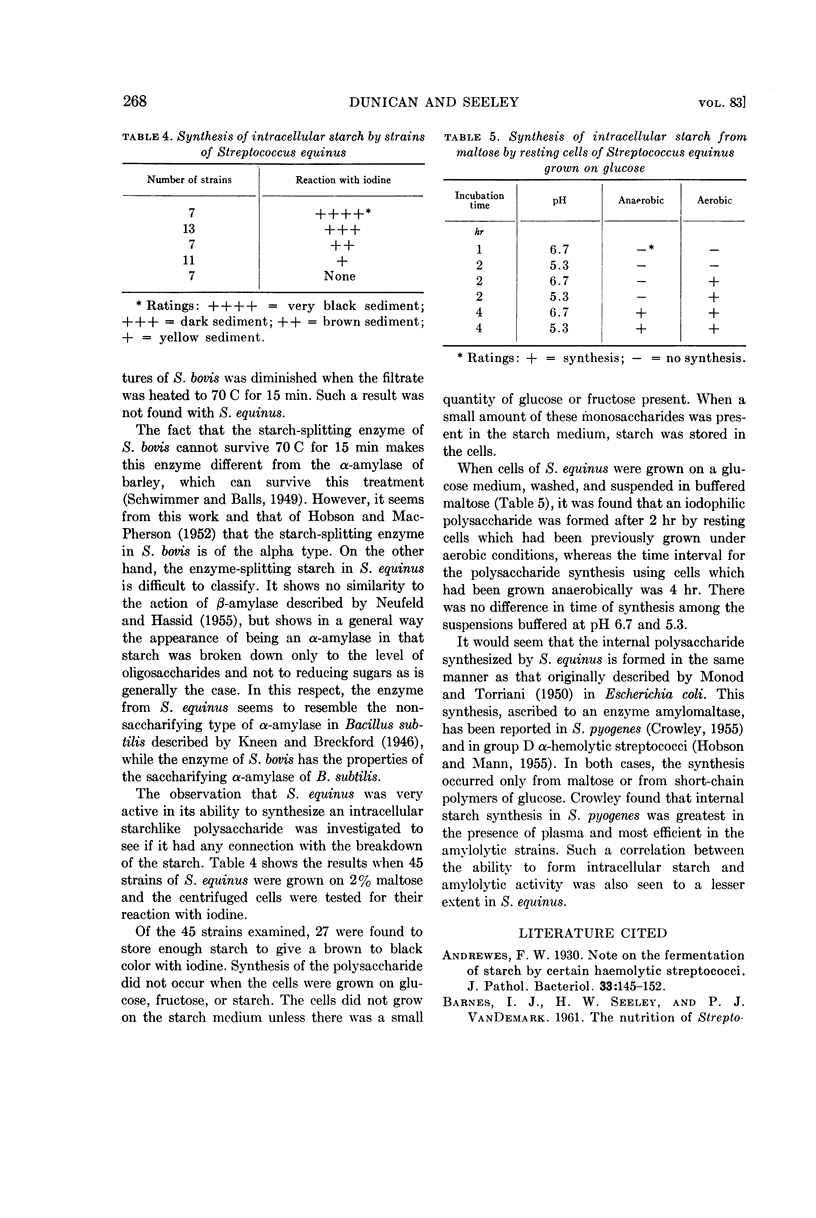
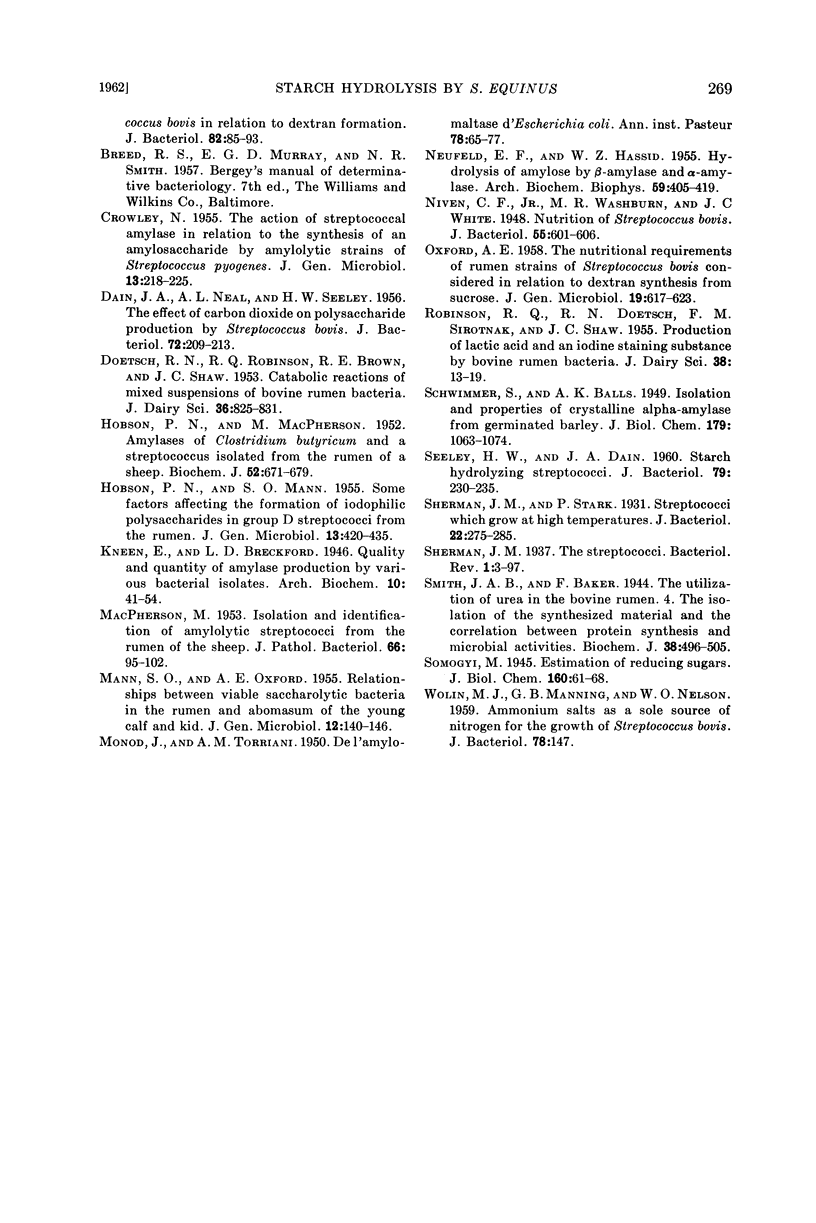
Selected References
These references are in PubMed. This may not be the complete list of references from this article.
- BARNES I. J., SEELEY H. W., VANDEMARK P. J. Nutrition of Streptococcus bovis in relation to dextran formation. J Bacteriol. 1961 Jul;82:85–93. doi: 10.1128/jb.82.1.85-93.1961. [DOI] [PMC free article] [PubMed] [Google Scholar]
- CROWLEY N. The action of streptococcal amylase in relation to the synthesis of an amylosaccharide by amylolytic strains of Streptococcus pyogenes. J Gen Microbiol. 1955 Oct;13(2):218–225. doi: 10.1099/00221287-13-2-218. [DOI] [PubMed] [Google Scholar]
- DAIN J. A., NEAL A. L., SEELEY H. W. The effect of carbon dioxide on polysaccharide production by Streptococcus bovis. J Bacteriol. 1956 Aug;72(2):209–213. doi: 10.1128/jb.72.2.209-213.1956. [DOI] [PMC free article] [PubMed] [Google Scholar]
- HOBSON P. N., MACPHERSON M. Amylases of Clostridium butyricum and a Streptococcus isolated from the rumen of the sheep. Biochem J. 1952 Dec;52(4):671–679. doi: 10.1042/bj0520671. [DOI] [PMC free article] [PubMed] [Google Scholar]
- HOBSON P. N., MANN S. O. Some factors affecting the formation of iodophilic polysaccharide in group D streptococci from the rumen. J Gen Microbiol. 1955 Dec;13(3):420–435. doi: 10.1099/00221287-13-3-420. [DOI] [PubMed] [Google Scholar]
- MACPHERSON M. J. Isolation and identification of amylolytic Streptococci from the rumen of the sheep. J Pathol Bacteriol. 1953 Jul;66(1):95–102. doi: 10.1002/path.1700660113. [DOI] [PubMed] [Google Scholar]
- MANN S. O., OXFORD A. E. Relationships between viable saccharolytic bacteria in rumen and abomasum of the young calf and kid. J Gen Microbiol. 1955 Feb;12(1):140–146. doi: 10.1099/00221287-12-1-140. [DOI] [PubMed] [Google Scholar]
- MONOD J., TORRIANI A. M. De l'amylomaltase d'Escherichia coli. Ann Inst Pasteur (Paris) 1950 Jan;78(1):65–77. [PubMed] [Google Scholar]
- NEUFELD E. F., HASSID W. Z. Hydrolysis of amylose by beta-amylase and Z-enzyme. Arch Biochem Biophys. 1955 Dec;59(2):405–419. doi: 10.1016/0003-9861(55)90508-7. [DOI] [PubMed] [Google Scholar]
- Niven C. F., Jr, Washburn M. R., White J. C. Nutrition of Streptococcus bovis. J Bacteriol. 1948 May;55(5):601–606. doi: 10.1128/jb.55.5.601-606.1948. [DOI] [PMC free article] [PubMed] [Google Scholar]
- OXFORD A. E. The nutritional requirements of rumen strains of Streptococcus bovis considered in relation to dextran synthesis from sucrose. J Gen Microbiol. 1958 Dec;19(3):617–623. doi: 10.1099/00221287-19-3-617. [DOI] [PubMed] [Google Scholar]
- SEELEY H. W., DAIN J. A. Starch hydrolyzing streptococci. J Bacteriol. 1960 Feb;79:230–235. doi: 10.1128/jb.79.2.230-235.1960. [DOI] [PMC free article] [PubMed] [Google Scholar]
- Sherman J. M., Stark P. Streptococci which Grow at High Temperatures. J Bacteriol. 1931 Oct;22(4):275–285. doi: 10.1128/jb.22.4.275-285.1931. [DOI] [PMC free article] [PubMed] [Google Scholar]
- Sherman J. M. THE STREPTOCOCCI. Bacteriol Rev. 1937 Dec;1(1):3–97. doi: 10.1128/br.1.1.3-97.1937. [DOI] [PMC free article] [PubMed] [Google Scholar]
- Smith J. A. The utilization of urea in the bovine rumen: 4. The isolation of the synthesized material and the correlation between protein synthesis and microbial activities. Biochem J. 1944;38(5):496–505. doi: 10.1042/bj0380496. [DOI] [PMC free article] [PubMed] [Google Scholar]
- WOLIN M. J., MANNING G. B., NELSON W. O. Ammonium salts as a sole source of nitrogen for the growth of Streptococcus bovis. J Bacteriol. 1959 Jul;78(1):147–147. doi: 10.1128/jb.78.1.147-147.1959. [DOI] [PMC free article] [PubMed] [Google Scholar]


